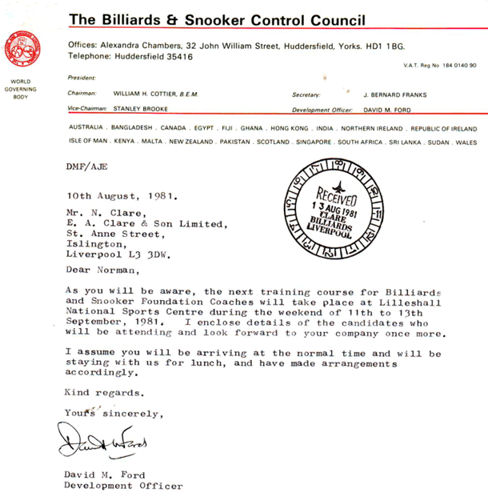Norman's Lectures
Introduction

Additional information that has been added to
Norman's 1979 lecture are shown in italics. All photographs have
been added but most are taken from the items Norman took with him
or photographs he used during his lectures. Norman mainly gave his
lecture on behalf of the Billiards & Snooker Control Council at
the training weekend for Billiard & Snooker coaches at the
Sports Councils Centre at Lilleshall. He was also frequently asked
to be the 'speaker' at many other functions.

THE DESIGN AND CONSTRUCTION OF BILLIARD TABLES AND THEIR
ACCESSORIES
I am sure we will all agree that we should not just consider the
existing design and construction of Billiard Tables and their
accessories, but that first of all we should look back into history
so far as we reasonably can, so that we can understand something of
the way in which the Billiard Tables and their Accessories have
developed.
Many people probably think Billiard Tables have never really
altered in design or construction since the game was first
invented. However, like many other very old games, the Billiard
Table and its equipment has slowly evolved in construction and
design over a very long period of time.
Various different games, all enjoying the name of "Billiards" are
played throughout the world. At some time in the past they probably
had a common origin, but in different countries they have each
developed in a different direction, with the result that games of
Billiards as played in countries as near to us as France and
Germany' are totally different from the game as played in the
United Kingdom and there are very great differences in the design
and construction of the Billiard Tables and Accessories.
In the United Kingdom and the British Commonwealth, there is now
something of a tendency for players to call the tables "Snooker
Tables" and to purchase 'Snooker Cues", and to even ask for
"Snooker Chalk".
The game of Snooker is of comparatively recent origin (see Article
on 'Origins of Snooker'), and we will have something more to say
about it later on in the series of lectures. Let me at this point
say that when ever we refer to a Billiard Table or any Billiard
Accessories you can generally take it that we are also at the same
time referring to Snooker Tables and Accessories., and also
including the many other different games which are played upon
Billiard Tables.
The United Kingdom plays the game of "English Billiards", and
naturally this is the game that has been taken by English emigrants
literally to the four corners of the earth, so that throughout what
we now know as the British Commonwealth, you will find that it is
the game of English Billiards which has become established.
However, the game which we generally refer to as "Continental
Billiards", which I think the correct name is "Carambolage", which
is played in most other European countries, has been taken by
emigrants from those countries to areas of French, German, Italian,
Portuguese, and Spanish influence., with the result that in those
parts of the world, which at one time or another came under their
control its the "Carambolage" game which has become established.
The principal difference which one can see at a glance is that the
Continental style tables do not have any pockets, and thus the game
is entirely made up of a series of canons, whilst the English table
has pockets at each corner and at the centre position of each of
the long sides of the tables.
In the United States of America, where the population is of very
mixed European origin, games of Billiards in general follow the
Continental style and are played upon tables without any pockets,
but at the same time a large number of different games, all of
which we generally refer to as "American Pool" are played on tables
which have pockets, very similar to English tables. Just to make
the game a little more involved, in some parts of the world
Billiards is played with four balls instead of the usual
three.
As a direct result of these many differences in the form of game
throughout the world, you will realise that it is not really
possible to organise true International Championships, as it is for
such games as Golf, Football, Table Tennis etc.
It would I think be a very good thing if we could try and work
towards International Standardisation of Billiard Tables
Accessories, and of course the rules of play. This however is
obviously a tremendous task, but perhaps we should start by
thinking about the problems involved.

